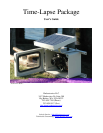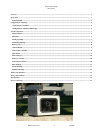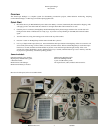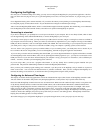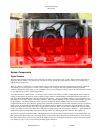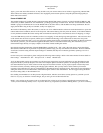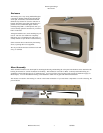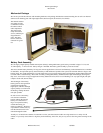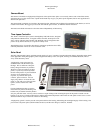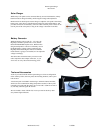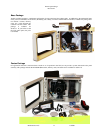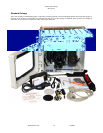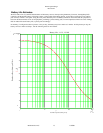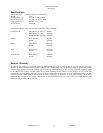Time-Lapse Package
Revision D
Harbortronics LLC 6 1/5/2007
Again, given some extra effort and cost, we may be able to use your current camera, but we’d like to suggest using a Pentax SLR.
These cameras use industry standard connectors, draw negligible power between pictures, and yield equivalent image quality to
Nikon and Canon cameras.
Pentax K100D/K110D
The standard package will include the latest generation Pentax Digital SLR camera. Currently we install a K110D (6 MPixels, APS
sized sensor), with the standard ‘kit’ lens from Pentax, providing a good range of usable zoom. We have word from Pentax that the
K110D is going to be eliminated in favor of the K100D. This is the same camera, with the addition of image stabilization. We will
supply the K110D as long as they are available, as they cost slightly less.
We install a 2 GB memory card in the camera, as well as a set of AA Alkaline batteries. These are not the best batteries to power the
camera under normal conditions, but will work nicely here. The external battery pack will power the camera, so the internal batteries
are only needed to maintain the camera settings and clock when the external power is disconnected, such as in shipping, or storage.
A second 2 GB memory card is also included, to allow ‘hot swapping’ of cards during long-term applications. The card access door
on the camera must be closed to operate, and the space is limited in the housing, so the camera must be removed to swap cards.
Given the quick release head, this is a very easy operation, and the camera will be re-installed with essentially an identical orientation
each time. If you desire, you can attach the supplied USB cable, and leave it attached in the housing. This would allow you to
download the images directly to a laptop computer, in the field, without touching the camera.
Note that the operating temperature of the K110D/K100D is specified for 0C – 40C. This is the same range as most other digital
SLR cameras. While there is no guarantee of operation beyond this range, you may well find that it works fine! We have anecdotal
word from a customer testing the Time-Lapse Package in a chamber, that they have not had any problems, operating to as low as
minus 60C.
For the lowest power consumption, please configure the following camera settings. Refer to the camera manual for more details on
these settings. Instant Review : Off Auto power off : 1 minute Manual focus
As far as photographic settings are concerned, we only have basic suggestions. For most applications you may find that using the
Program mode (P) is perfectly adequate. The camera will adapt the aperture and shutter speed to suit the lighting conditions. This
does mean that there may be visible variations in the exposure from frame to frame. If your project requires consistent exposures
from frame to frame, accurately reflecting the changing light conditions, then you may need to set the camera up for manual
exposures. This could take a few days of experimenting to determine the proper settings however! There may be some advantage to
setting the camera for a fixed white balance, rather than using the camera’s auto white balance. We also suggest setting the ISO to
the lowest setting (200), for the minimum noise.
Our standing recommendation is to take pictures at high resolution, and take several times as many pictures as you think you will
need. It’s very easy to downsize or discard images, but you can’t get more of them after the fact.
Ideally, you would set up the system a week or two ahead of time, collect lots of test images, and adjust the exposure before the
‘event’ you are monitoring actually occurs. If you have this luxury, congratulate yourself for thinking ahead… you are in a minority!



